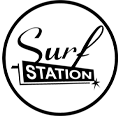Mourning the loss of surf spots of yore

“Surfing was a lot more magical back then,” award-winning photojournalist, surfer and consummate waterman Walter Coker reveals with a sly grin. “I’m like all the old guys: I think it [surf culture] used to be a lot better.”
While every surf town in the world has its salty dogs, pining for the waves of yesteryear, the difficult truth is that decades of near-constant beach renourishment efforts have reshaped Florida’s coastline, forever altering some of the area’s most iconic surf breaks.
For those who are unfamiliar, beach renourishment or “dredging” is a process of replenishing eroded areas of the coastline with supplementary sediment or sand. In the case of St. Johns County, many of the area’s beaches had eroded completely by the early 1970’s, including the sand around the St. Augustine Beach Pier. In an effort to restore this portion of the coastline that many deemed essential to the local economy, supplementary sand was sourced from two sandbars located near the entrance to Anastasia State Park.
Unfortunately, those two sandbars formed what were arguably two of the state’s most consistent breaks: Blowhole and Middles. The loss of sand left both as shadows of their former selves.
Like these two iconic breaks, many others up and down the coast have faded. But they live on in the memories of those who were lucky enough to experience their glory. I reached out to a few of those folks to mourn the loss of surf spots of yore.
Blowhole
“We just couldn’t believe our eyes when we saw it,” Coker says of the legendary East Coast break. “We’d just decided to go for a drive on the beach and then all of a sudden these peaks are coming in. It was twice the size as everywhere else that day. I’ll never forget it.”
Coker was feasting his eyes on A-framed peaks reeling across the break better known as the wave-magnet, Blowhole. Packing size and power unmatched by other waves in the region on any given day, Blowhole quickly became a surfing destination for the sport’s elite.
Atlantic Beach native, former head of the Eastern Surfing Association and surf history buff Mitch Kaufmann recalls the lawless nature of the beach’s culture.
“I had dreams for decades about driving on the beach at Blowhole and the waves being phenomenal,” says Kaufmann. “The scene on the beach played such a big role in those dreams because you had miles of beach filled with good surfers waiting to paddle back out. It was like an all-day party.”
Accessible by car, Blowhole became a breeding ground for the debauchery perpetuated by the hardcore surfers of the 70s.
“There’d be people with giant living room speakers in the backs of their trucks and on the tops of their cars blaring Lynyrd Skynyrd,” remembers Coker. “People would carry kegs down there in the backs of their cars. Everyone down there was a little bit nutty.”
Middles
A better kept secret, a break known as Middles, was located about a third of a mile north of Blowhole.
“A lot of people didn’t surf Middles in those days, they’d just stop at Blowholes,” Coker explains. “Then Middles started to get slowly discovered. At both spots you could sit outside and see the set way out the back. That was an indicator that a set was going to come in about 30 or 40 seconds.”
Just like Blowhole, Middles provided surfers with the top-to-bottom barrels that are often hard to find in our region. As the breaks’ essential sandbars deteriorated and driving was no longer permitted along the beach, the waves began to dwindle and the crowds were soon to follow.
“When they stopped driving in the park, a lot of people never surfed there again,” Coker recalls. “In the heyday, there would be 75 to 100 people in the water. After that, even when it was good, there’d be less than 25 people.”
Vilano Beach
“When we’d leave Blowhole, we’d go to Vilano and it would be firing,” reminisces Kaufmann. “Way better than today. It was barreling everyday.”
Vilano Beach’s heavy, shallow beach-break barrels have long been a proving ground for local talent. Rife with localism, the break was a destination wave for those outside of St. Johns County. World-renowned surfer, photographer, and videographer William “Wild Bill” Eichholz policed the water while setting the tone for the break.
“Wild Bill was just a classic,” recalls Tory Strange, founder of the Surf Station surf shop. “He was the first famous surfer to ever come out of St. Augustine. When he was at Vilano, he’d paddle out with a cigarette and then decide to surf switch frontside and backside. There was just nobody like him.”
With the passing of time, Vilano Beach has been subjected to erosion and storm surge, stripping the break of sand essential to making the wave more manageable for most surfers.
“Vilano was really a different wave back then,” says Coker. “It still breaks good, but back in those days it broke further off the beach and it was friendlier, but it was still a barrel.”








